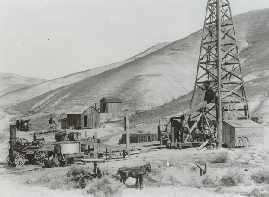|
The McKittrick Tar Pits
| History of the Tar Pits | Geology of the Tar Pits | You might want to check out these links as well: | Offshore Oil Seeps | USGS Seep Page |
Indians, Tar Pits and Tar Mines
When Pahmit, a Dumna Yokuts, was about 105 years old, he remembered watching pioneers at Oil City, near Coalinga, collecting tar from the same seeps he and his family once mined. Seeps were also being worked about this time at McKittrick and Taft, west of Bakersfield, sites where Yokuts once collected tar as well. The pioneers used the tar they collected mainly for waterproofing roofs and greasing wagon wheels. Inevitably, the Wogitu tar seeps attracted the attention of entrepreneurs who sought to capitalize on this unusual resource. The most successful entrepreneurs were John Hambleton and Judge Lovejoy who in 1864 dug shallow pits, 8 to 10 feet deep, near active seeps in what became known as the Asphalto area. They built a small still and refined the tar they collected into lamp kerosene which was shipped by wagon to their agents in Stockton. Working the asphalt pits was difficult and dangerous. Valley temperatures often hovered around 120 degrees, reaching as high as 140 degrees in the pits. Consequently, work was limited to twenty-minute shifts, lest the workers become debilitated by the heat or overcome by noxious fumes rising from the seeps. By 1891, several 5-foot by 6-foot foot shafts, many lined with railroad ties for stability, were sunk up to one-hundred feet deep into the McKittrick tar seeps. Because the miners working these shafts quickly became covered with asphalt, they usually worked naked. At days end, they cleaned themselves with case knives or wooden scrapers made for race horses, then washed with distillate. Because it was impractical to clean up at noon, they ate lunch 'au naturale' sitting on newspapers at the camp mess. Rather than dig pits, some prospectors, many of them former Mother Lode miners, dug tunnels in search of the "black gold" of the San Joaquin. These mines were located just outside of McKittrick, a pioneer town that sprang up near the old Asphalto tar pits. The mines, some up to 300 feet in length, yielded a high-quality asphalt, as much as 90-percent pure, that was better quality than asphalt produced on the island of Trinidad, then the world's main supplier for this resource. Generally, McKittrick asphalt was used to pave streets and sidewalks in San Francisco or to grease log skids in the timber country. Apparently, this commodity was valuable enough to command $30 a ton in the days when a nickel might buy a decent meal.
Picture Gallery of the McKittrick Tar Pits
|
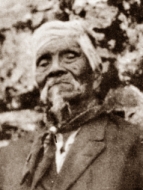
Pahmit, a Dumna Yokut. |
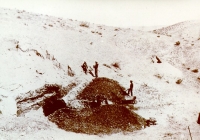
Digging an asphalt mine. |
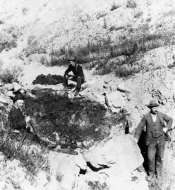
Photo of a tar pit. |
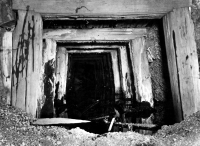
Entrance to an asphalt mine. |

Modern tar pit near McKittrick. |
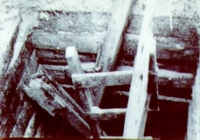
Entrance of a tar shaft. |
| FAMOUS GUSHERS |
| California |
| Lakeview Gusher |
| Russia (Baku) |
| Middle East |
| Pennsylvania |
| Texas |
| Oklahoma |
| Gulf of Mexico |
| Latin America |
| Pioneering Geolgists |

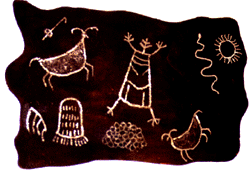 Spanish explorers traveling through California in the late 1700s observed Yokuts Indians using asphalt for many purposes. In particular, the Tulumne Yokuts collected tar from natural seeps that oozed up near their village of Wogitu, near McKittrick on the west side of the valley. The asphalt was molded into fist-sized tar balls for trading, waterproofing, and as an adhesive. It was also used for decorating by inlaying bits of abalone shell into tar stuck on pottery, knives, masks, and clothes.
Spanish explorers traveling through California in the late 1700s observed Yokuts Indians using asphalt for many purposes. In particular, the Tulumne Yokuts collected tar from natural seeps that oozed up near their village of Wogitu, near McKittrick on the west side of the valley. The asphalt was molded into fist-sized tar balls for trading, waterproofing, and as an adhesive. It was also used for decorating by inlaying bits of abalone shell into tar stuck on pottery, knives, masks, and clothes.